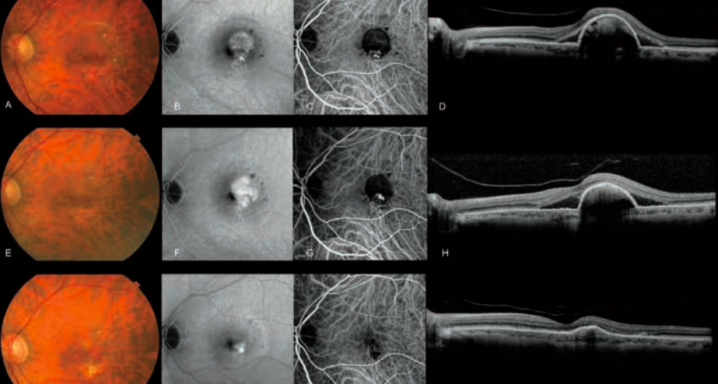New scientific solutions for exudative AMD when conventional treatments do not work
10/07/2016 ·
The Institut de la Màcula performs diagnosis with indocyanine green angiography using a diode laser that can be effective in complex cases of Polypoidal Choroidal Vasculopathy (PCV).
The technique can be very useful for specific refractory cases.
The Institut de la Màcula and the Barcelona Macula Foundation work constantly on research to find a response to the multiple unknowns that we still face in a variety of vision pathologies today.
In this process, Dr. Jordi Monés, MD PhD, the Director of the Institut de la Màcula and the Medical Director of the Barcelona Macula Foundation, together with Dr. Marc Biarnés, PhD, from the Institut de la Màcula and Dr. Josep Badal, MD, of the Moisés Broggi Hospital, explain a new practice in a document published in Retinal cases and brief reports. This could be the start of an effective, innovative method for the treatment of cases like PCV, which is defined as a vascular network with dilations of choroidal vessels and rounded ends.
This type of AMD frequently affects black and Asian patients, through causes that are initially genetic and possibly environmental. These are ethnic groups in which it has been shown that neovascular AMD tends to occur in younger ages too (especially in Asian patients).
The clinical manifestations of PCV are currently numerous. The most common characteristics demonstrate that patients suffer detachment and haemorrhaging of the pigmentary epithelium of the retina and which, in the main, result from the protrusion of some choroidal vessels.
In addition, the eye fundus of patients with PCV may lack drusen (deposits located under the retina, composed of lipids, which increase the risk of developing AMD). In these cases, indocyanine green angiography is the methodology that provides confirmation of this pathology.
The clinical case successfully conducted at the Institut de la Màcula considered the profile of a 65-year-old man. He was referred to the IM with a diagnosis of exudative AMD in his left eye and with a corrected visual acuity of 20/25 in his right eye and 20/32 in his left eye.
The patient’s case was singular because, despite receiving as many as eight antiangiogenic injections, they only had a minimal effect.
Given this uncommon situation, Dr. Jordi Monés’s team chose to apply two sessions of Verteporfin Photodynamic Therapy (TFD) at an interval of only two months. In addition, two injections of ranibizumab 0.5 mg were also applied to achieve improved regression of the polypoidal lesion.
Once the two-month period had elapsed, monitoring of the patient showed visual acuity to be 20/32 in his right eye. He continued to present both detachment of the pigmentary epithelium in his left eye and subretinal liquid.
As treatment of the polypoidal lesions with a thermal laser could not be regarded as a treatment option due to its subfoveal location, alternative therapies were explored. As a result, it was decided to use indocyanine green angiography again.
This new angiography identified a vessel that fed the polypoidal complex of the choroidal circulation. The diode laser guided by the indocyanine green angiography had previously been discussed with the patient and was used with a wavelength of 810 nm, a power of 300 mW, a duration of 0.2 milliseconds and a point measurement of 100 microns in the feeding vessels, which are responsible for providing circulation to the polypoidal structures. All this was combined with an intravitreal injection of ranibizumab 0.5 mg two days later.
With this practice, the occlusion of the feeding vessels blocked the blood flow to the polyps and thereby enabled the levelling of the detachment of the pigmentary epithelium, the disappearance of the subretinal liquid and the regression of the polyps only two weeks after the treatment.
This practice is innovative in those patients who do not respond to the treatments that are habitually used for this pathology. It resolved the patient’s polypoidal structures, which were in regression and showed subretinal exudation, and preserved visual acuity without adverse effects.
The singularity of this practice gives us reason to believe that in selected cases of PCV the diode laser guided by indocyanine green angiography is an alternative effective therapy. This is especially likely in the situations where refractory patients do not respond to photodynamic therapy or antiangiogenic therapy.






